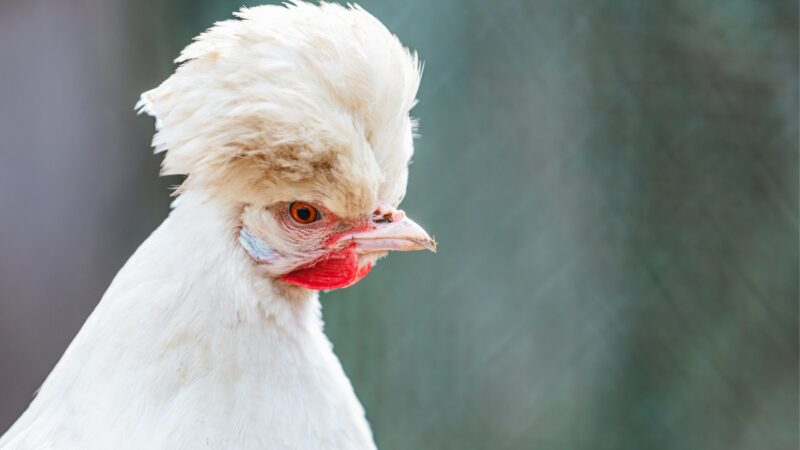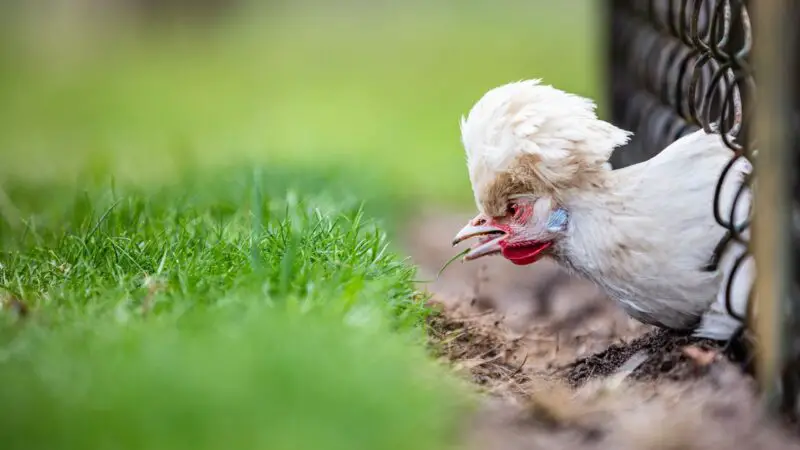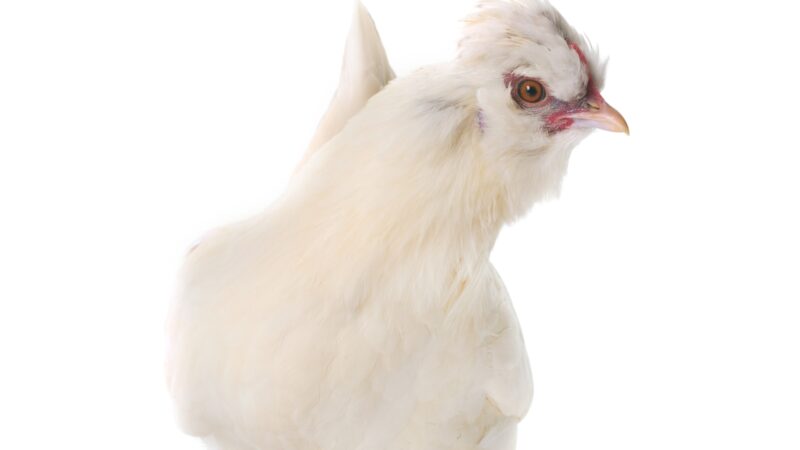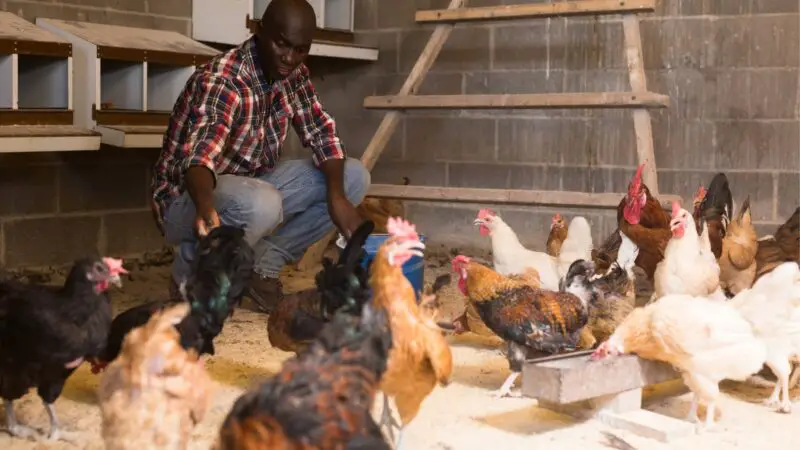Raising backyard chickens can be an enjoyable activity and rewarding experience. Selecting the right breed for you is your most important choice in this endeavor. One breed to consider is the Sultan chicken to own a friendly, attractive bird!
Sultan chickens are a breed known for their snow-white appearance and distinctive feathering. They are primarily raised for poultry exhibitions and are prized for their ornamental value. They also make wonderful pets due to their temperament.
To know more about Sultan chickens, their history, appearance, distinctive characteristics, egg-laying capabilities, and other interesting information, read this article further!
Sultan Chicken History

The Sultan Chicken was called Serai Täook, meaning “Fowl of the Sultan” or “Sultan’s Fowl,” and was bred in Turkey in the 14th century. Legends claim that these chickens were utilized as living ornaments in the gardens of sultans or Turkish royals in Constantinople, hence their given name.
Elizabeth Watts, the editor of the Poultry Chronicle, a London-based newspaper, received Sultan chickens from a friend living in Constantinople. She wrote that the fowls arrived in dirty, mud-stained condition, with feathers still matted together. Months later, Elizabeth noticed that the birds were pure white after they molted.
In 1867, the first Sultan chickens were introduced in America when poultry expert and author George O. Brown received birds. He wrote that the chickens were the most content and tamest birds he had ever possessed. It wasn’t until 1874 that the birds were included in the American Poultry Association’s Standard of Perfection.
The birds almost faced extinction in the 1930s but have, fortunately, increased their numbers since then. Today, however, Sultan chickens remain a rare breed.
What’s Special About Sultan Chickens?

Sultan chickens are among the few fowls with five toes on each foot. They are also known for their snow-white feathering, which is a highly esteemed ornamental value in many breeders.
Sultan Chicken Identification

What Do Sultan Chickens Look Like?
Large-sized fowl with complex feathering are crested, muffed, bearded, and snow-white in color. They have a V-shaped comb, large nostrils, reddish eyes and face, pale yellow or white colored beak, feathered shanks and toes, droopy-looking wings as they hold them low, and vulture hocks.
How Long Does a Sultan Chicken Live?
Sultan chickens live for about 5 to 8 years, longer if well cared for.
What Do Sultan Chickens Eat?
Sultan chickens eat fruits, grains, insects, vegetables, and scraps such as bread. Oats and scratch-cracked corn are a good treat for them but should only be given in moderation. They are fed chick starters, laying feed, and molting ration.
How Big Do Sultan Chickens Grow?
Currently, there is no information regarding Sultan chickens’ size. However, since they are large chickens, they are anywhere between 15 to 26 inches tall.
Are Sultan Chickens a Heavy Breed?
Sultan chickens are of average weight compared to other large breeds. They are the smallest among them.
Sultan roosters weigh up to 6 pounds, while hens weigh up to 4 pounds. Bantam Sultan roosters weigh 26 ounces, while Bantam Sultan hens weigh 22 ounces.
Sultan Chicken Wingspan
No information is known about the wingspan of Sultan chickens. Since they are large birds, they may have a wingspan of 2 to 3 feet in length.
What Is Sultan Chicken Known For?
Sultan chickens make wonderful pets and are grown primarily as ornamental fowl and kept for poultry exhibitions due to their snow-white appearance.
Where Do Sultan Chickens Originate?
Sultan chickens originated from Turkey during the Ottoman Empire in the 14th century. Their name was Serai Täook, and they served as ornamental species in the gardens of Turkish royals.
What Are the Distinct Characteristics of a Sultan Chicken?
Due to their distinctive crest, they are prone to predation and bullying by assertive breeds. They also do not tolerate cold climates since they are easily susceptible to frostbite.
Sultan Chicken Temperament
Sultan chickens like to be around people, and they even like to be held. Roosters are not known to be aggressive. They are also quite chatty but not loud.
Are Sultan Chickens Good Egg Layers?
Sultan chickens are not considered good egg layers since they produce less annually.
How Often Do Sultan Hens Lay Eggs?
Sultan hens are infrequent egg layers and can only produce 50 to 60 eggs a year, compared to other chickens that can lay one egg nearly daily.
What’s the color of Sultan Chickens’ eggs?
Sultan chicken eggs are white. However, some Sultans may lay light brown eggs.
How Many Eggs Do Sultan Chickens Lay?
Sultan chickens lay 50 to 60 eggs a year.
What Age Do Sultans Start Laying?
They start producing eggs in about 10 months, later than other chickens that usually begin as early as four and as late as 8.
Sultan Chickens Care Tips

Housing
A good quality coop is important for backyard chicken operations. It can be as grand as a special brooder house, but it can just be a renovated building—as long as they protect the chickens against tough weather conditions and predators. Make sure they have a place to roost.
For the first month of age, chicks should be confined in the brooder area using a chick guard that is preferably 24 inches tall. They will require half a square foot of space up to 6 weeks of age. Adult birds require about 3 or 5 square feet of space, including outdoors.
The coop should also be thoroughly cleaned and sanitized regularly, including troughs, surrounding walls, nests, and perches. Old litter should be removed, and feed and watering equipment should be disinfected.
Heating
There should also be an area in the coop that is well-insulated, preferably with a heat lamp, for winter months as well as to provide ventilation for the birds, especially for chicks since they are sensitive to temperature changes and are not able to regulate their body heat.
The heating source, preferably a traditional 250-watt red heat lamp or a brooder heat plate, should be 95°F for the first week. The temperature is then reduced by 5 degrees each week until they reach 1 month old.
Nutrition
- Chick Starter (0 to 6 weeks). Chicks that have just hatched need a diet rich in high-energy carbohydrates, usually corn, and highly digestible protein, usually soybeans.
- Pullets (6 to 18 weeks). As chicks grow, they need less protein and more energy. As such, a pullet or grower ratio with low protein levels ensures that your growing chickens don’t grow too fast.
- Laying Hens (18 weeks plus). A laying feed with increased vitamin D, calcium, and phosphorus should be provided. Supplement oyster shells at night when your hens produce eggs with thin eggshells.
- Molt. Usually, in commercial chicken operations, a special diet is provided for chickens when they molt. For backyard operations, you can continue using a laying hen ration.
Feeders and Water
Make sure your chickens have easy access to feed and water all day, every day. Clean their feeding area and regularly replace their water. A 15-inch diameter tube feeder can feed 30 birds, while a 1-gallon waterer is enough for 10 birds.
Manure Management
Fecal matter, wet litter, spilled feed, and feathers are manure and should be disposed of regularly. A clean coop and brooder area will help reduce the risk of spreading diseases among your chickens. When cleaning, wear a dust mask since inhaling dried chicken manure may potentially be harmful to humans.
Chicken Health
Healthy birds look alert, have bright eyes, and are active. They will constantly move around as they peck, dust, and scratch, except on hotter days when they usually find shade. Make sure to monitor each chicken’s consumption and other behaviors.
Breeding Sultan Chickens
Sultan chickens begin laying eggs at around 10 months and can continue for 5 to 10 years, depending on their health and environment. As such, hens need at least 12 to 14 hours of light daily to lay eggs. You can simply use a regular light bulb to supply them. Note that layers need nest boxes.
Sultan Chicken Common Health Issues
| Cause | Symptoms | Bird Age Affected |
| Avian Influenza | Respiratory problems, appetite loss, listlessness, lower egg production, face swelling, dehydration, and bloody discharge from nostrils | All ages |
| Fowl Cholera | Appetite loss, green discharge, darkening and/or swelling of head parts, coughing | All ages |
| Fowl Pox | It comes in two forms: wet pox, which is characterized by pustules found in the sinuses, mouth, and larynx, and dry pox, which is characterized by wart-like lesions or scabs. | All ages |
| Marek’s Disease | Paralysis (inability to lift wings), blindness, lameness, gasping, or a combination of these symptoms | 3 weeks to 6 months old |
| Newcastle Disease | A sudden drop in egg production, respiratory problems, paralysis, ticking, watery discharge | All ages |
| Vitamin E Deficiency | Loss of balance, reddish black swelling found along the abdomen and falling over backward | Young birds |
Related Questions
Are Sultan Chickens Rare?
Sultan chickens are rare, and they have been rare since their introduction in England in 1854.
Can Sultan Chickens Fly?
Sultan chickens can fly, and they are prone to flying when possible. This is why they must be situated in a coop with a roof, so they don’t fly away.
Are Sultan Chickens Hardy?
They can’t thrive in cold weather. They can get frostbite, break their feathers, or get their feet all caked up.
Why Are Sultan Chickens Endangered?
They are not popular among breeders. Additionally, they are easily and heavily predated due to their all-white plumage and distinguishable characteristics.
How Much Are Sultan Chickens Worth?
Sultan chickens cost anywhere between $6.55 to $10 for baby chicks. Mature chickens are rarely sold and are very expensive.
Are Sultan Chickens Broody?
Sultan chickens do not go broody.
How to Tell Male From Female Sultan Chickens?
Males have larger comb, wattles, and spurs. They have longer and more pointed hackle, sickle, and saddle feathers. They also have sex organs that can be detected by trained professionals, although it is not easy.
Are Sultan Chickens Aggressive?
Not even the roosters are known to be aggressive.
Are Sultan Chickens Loud?
They can get quite chatty but not loud enough to be disturbing.
